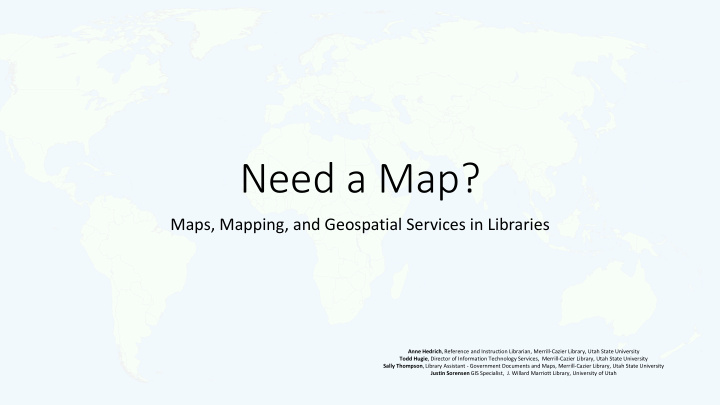



Need a Map? Maps, Mapping, and Geospatial Services in Libraries Anne Hedrich , Reference and Instruction Librarian, Merrill-Cazier Library, Utah State University Todd Hugie , Director of Information Technology Services, Merrill-Cazier Library, Utah State University Sally Thompson , Library Assistant - Government Documents and Maps, Merrill-Cazier Library, Utah State University Justin Sorensen GIS Specialist, J. Willard Marriott Library, University of Utah
When was the last time you used a map? What did you use it for? • Planning travel – local and distant • Genealogy research • Find out about a place that someone in your family has moved to • School research • City governments for planning • Market research for a business • Find out about a place in the news • Historical research • Decoration • Design ideas • Status symbol!
Maps are Useful for Information and to Show Patterns https://www.nytimes.com/interactive/2017/03/21/climate/how-americans-think-about-climate-change-in-six-maps.html?_r=0
Maps can Make Things Clearer, More Quickly
From: http://www-personal.umich.edu/~mejn/cartograms/
https://en.wikipedia.org/wiki/View_of_the_World_from_9th_Avenue#/ media/File:Steinberg_New_Yorker_Cover.png
http://www.funnyordie.com/articles/a106c8188f/the-map-of- america-as-seen-by-a-new-yorker
Terminology • Maps • Geospatial services • Geospatial resources • Geographic information systems (GIS) • Geolocation • GPS (global positioning system) • Geotagging/Geocoding • Geo-IP • Geocaching
Why maps in libraries? For the same reason we have other collections and services in our libraries- because they are useful to people, because people might not have access to them otherwise, because we can provide help in using them to find information and for enjoyment. Including maps of our libraries! Floors, levels, collection locations.
Map Libraries
Map Collections in Libraries • Historic maps (worldwide, regional, local) • Road maps and travel atlases • Wall maps (worldwide, regional, local) • Atlases – general (world, state, county) and thematic (political, climate) • Globes • State and local government maps • “topo maps” or “quads” USGS Quadrangle Maps • U.S. Government produced maps: USDA (soils maps, Forest Service maps, NOAA, Census, CIA, Defense Mapping Agency) • United Nations maps, maps from mapping offices in other countries • Helpful to have staff in the library that can help people find and use maps
Changes with Technology – more geographic information, more formats • Aerial photography • Satellite imagery • Computers
Online Maps and Geographic Information • Scanned maps from print collections • E-versions of atlases and maps • Directional maps created by organizations, businesses on websites • Map interfaces such as Google Maps, MapQuest, Google Earth, OpenStreetMap, Scribble Maps • Aerial photographs and satellite imagery • Geographic data sources and repositories
GIS (Geographic Information Systems) • Wikipedia: A geographic information system ( GIS ) is a system designed to capture, store, manipulate, analyze, manage, and present spatial or geographic data. • Libraries use GIS for planning, understanding their communities • Libraries provide services related to GIS in a number of different ways: • Lead people to data • Provide hardware and software • help people use GIS
Other Geospatial Services • Housing maps created in the community (academic libraries and IRs; public library local special collections) • Create maps from items in library collection (e.g. where research on a topic is being done) • Enhancing a collection by tying it into maps (e.g. pioneer diaries on a map) • Creating a local resources online geospatial guide (local attractions) • Programming with geospatial information: creating maps, contributing to online maps (OpenStreetMap), geocaching
Maps, Mapping, and Geospatial Services in Your Library • What uses for maps and geospatial services might your patrons have? • Consider: community activities, popular personal activities, unique local resources (cultural, natural), ethnicity and culture of local population, kinds of businesses, area history, student research areas • Consider who you might work with to make a service available through cooperative effort • There is a wealth of options – from simple and inexpensive to resource intensive and complex – choose what is right for your library
Resources • ALA Map & Geospatial Information Round Table (MAGIRT) www.ala.org/magirt/ • ESRI Environmental Systems Research Institute http://www.esri.com • Maps and GIS journal articles (found in library research databases) • Local teachers and practitioners http://www.uen.org/k12educator/ and search GIS (for example) • Online browsing • Other librarians
Recommend
More recommend